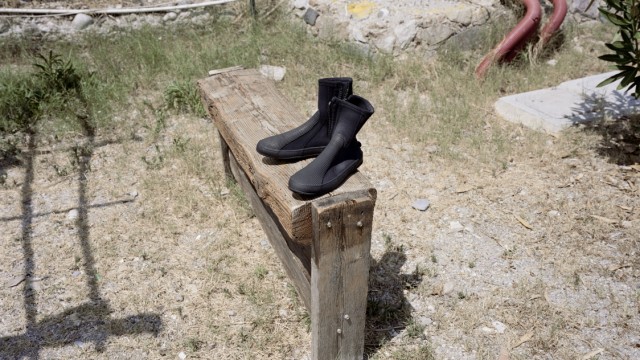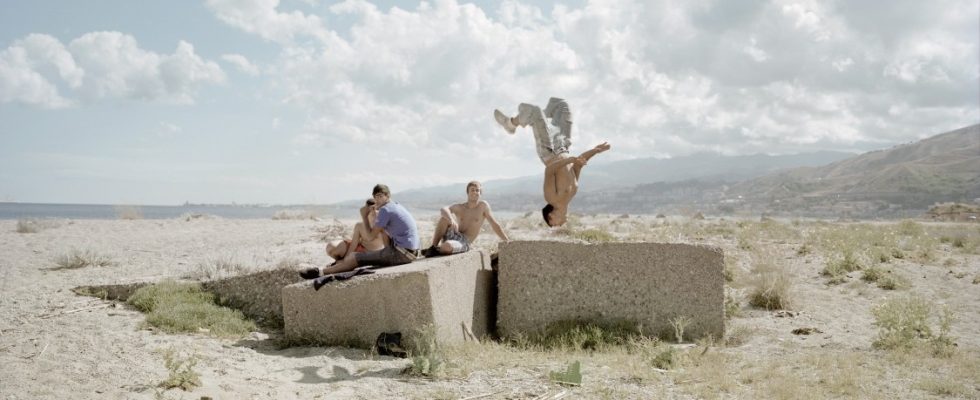Giuseppe Micciché has been carrying out an irritating undertaking since 2005: He regularly photographs something that doesn’t even exist – the bridge that will one day connect the Italian mainland with Sicily. It is questionable whether it will ever be built. As an idea, however, it has existed for almost a century.
The Italian dictator Benito Mussolini first spoke publicly about such a connection during the Second World War. The plans have been taken up again and again, most seriously by Silvio Berlusconi. Large sums of money have repeatedly been invested to advance the project. And the efforts have been stopped again and again. Finally, a tunnel was brought into play as an alternative to a bridge.
There are two motifs in Giuseppe Micciché’s photo book “No Ponte” (in German: no bridge) in which a bridge can be seen. Once on a mural on the occasion of the Fiera di Messina trade fair in 2006 and once as a model, also exhibited in Messina in 2006. If it were actually built, it would be the longest suspension bridge in the world to date, built on sandy ground and in the middle of an earthquake region. A crazy superlative and the central point why the bridge is to this day little more than a simulation game, a utopia. As such, however, it leads many people to dreams and hopes. This bridge scares others.
A mural of the bridge that doesn’t exist, on the occasion of the Fiera di Messina trade fair in 2006.
(Photo: Giuseppe Micciché)
Giuseppe Micciché’s grandparents emigrated to Switzerland in the 1960s. Since then, they and their descendants have also often crossed the Strait of Messina, the strait between Sicily and Calabria, when they went back to their old home for vacation and then back to their new home for work. Micciché remembers the numerous ferry rides with the slow approach to “our village”, where he did not grow up, but in Alpine emigration. He particularly fondly remembers the arancini, Sicilian rice balls, that were always served on the ferry and that spread the smell and taste of the island before Micciché even set foot on it.
A bridge would connect the mainland and the island far more closely than ferries. It would bring prosperity because goods and people could be transported across the sea much more quickly and easily. She is a hope for many people on both banks of the Strait of Messina. And that is what Giuseppe Micciché photographs: the obsession and at the same time the fatalism associated with the imaginary bridge. “No Ponte” portrays a region at a standstill. Little happens in the pictures. Even a shot of young men on the beach at Sant’Agata, one of whom is doing a somersault while the other three are watching in a rather bored manner, does not convey any dynamism. But the impression that time is being wasted here. There’s no one to impress with the acrobatic feat, there’s nothing to do but hang out.
What is being built on the banks of the Strait of Messina is at best half-finished and may remain so for the foreseeable future. What has been completed is already crumbling and falling apart again. The bridge, as these images make clear, would be an important catalyst for the development of the region. But as it is, a lot of things are languishing. And yet things change, slowly and not always with a discernible purpose, at least not to an observer from afar.

Diving shoes drying.
(Photo: Giuseppe Micciché)
And of course there is an everyday life for people here; they can’t just wait for something that may never happen. They go about their work or their hobbies. Fishermen can be seen in the photographs painting their boats, a diver, residents hanging out their laundry or burning waste. People gossiping, debating, observing. Teenagers taking a bath. Flying traders.
The images show a side of Sicily as well as Calabria that travelers usually ignore. If they use the ferry at all and not a plane, they will quickly travel further to the south or west of Sicily, towards Palermo or Taormina, for example. And on the way back, the focus is on the destination Rome. In the mobility-driven present, “No Ponte” is also an exploration of the immobile, the persistent, the unchanging. The book talks about the need to come to terms with the circumstances. And the comfort of what is manageable and calculable.
Giuseppe Micciché: No Ponte. Edition Patrick Frey, Zurich 2023. 156 pages, 68 euros.

